| Conventional long form | Democratic Socialist Republic of Sri Lanka | ||||
| Conventional short form | Sri Lanka | ||||
| Former | Ceylon | ||||
| Size | |||||
| Area | 65,610 sq km | ||||
| Land | 62,705 sq km | ||||
| Inland Waters | 2,905 sq km | ||||
| Length | 445 km | ||||
| Breadth | 225 km | ||||
| Capital | Sri Jayewardenepura | ||||
| Commercial Capital | Colombo | ||||
| Government | Sri Lanka, is a free, independent and sovereign nation with a population of 20.3 million (2011 est). Legislative power is exercised by a Parliament, elected by universal franchise on proportional representation basis. A President, who is also elected by the people, exercises executive power including defense. Sri Lanka enjoys a multi party system, and the people vote to elect a new government every six years. | ||||
| Population | 20.3 million | ||||
| Population Density | 325 Population per sq km | ||||
| Population Growth Rate | -0.65 (Provisional) | ||||
| Life Expectancy at Birth | Female - 78.6 , Male - 72.0 (2011-2013) | ||||
| Literacy Rate | 93.1% | ||||
| Digital Litracy Rate | 60% | ||||
| Languages | Sinhala & Tamil is widely spoken throughout Sri Lanka. | ||||
| Ethnic Mix |
Sihalese - 74.9% Sri Lankan Tamil - 11.2% Indian Tamil - 4.1% Sri Lanka Moor - 9.3% Burgher - 0.2% Malay - 0.2% others - 0.1% (descendants of Dutch and Portuguese colonist) and others 0.5% (2012 est) |
||||
| Religion |
Buddhist - 70.1% Hindu - 12.6% Islam - 9.7% Roman Catholic - 6.2% Other Christian - 1.4% Other - 0.0% |
||||
| Climate | Low lands – tropical, average 27°C Central Hills – cooler, with temperatures dropping to 14°C. The south-west monsoon brings rain to the western, southern and central regions from May to July., while the north-eastern monsoon occurs in the north and east in December and January. Sri Lanka boasts of a good climate for holiday-makers throughout the year. | ||||
| Per-Capita Gross National Income (at current prices) | USD 3,268 (2022, Provisional) | ||||
| Annual per capital GNP | US $2580 (2011 est) | ||||
| Per Capita GDP (at current market prices) | Rs. 1,088,667.15 (2022, Provisional) | ||||
| Industries | Metal, dye & mold machinery tools & allied industries; Timber , Wood based industries & furniture industries; Autometive assembly electronics & automotive industries; Electrical related industries; Western & local pharmaceatical & allied industries; Granite , tile , pottery , ceramics & building related industries; Lnks , chemicals, printing materials & allide industries; Cosmetic & allied industries; Gem & jewellry related industries; Minerals & allied industries; Garment, Textiles & allied industries | ||||
| Agriculture - Products | Paddy, Tea, Rubber, Coconut, Cereals, Pulses, Oil seeds, Roots and tubers, Low country vegetables, Up country vegetables, Minor exports, Fruits, Other perennial, Leaves, Other, Livestock, Slaughter, Milk, Fisheries and aquatic resources | ||||
| Currency | Sri Lanka follows decimal currency systilable in the denominations of Rs. 2,10,20,50,100,200, 500,1000,2000, and 5000 in Rupees (Rs.) and cents (Cts.) with 100 cents equal to a rupee. Currency notes are avaCoins are issued in values of Cts.1,2,5,10, 25 and 50 and Rs.1,2,5 and 10. The intervention currency continuously will be the US Dollar. | ||||
| Visa | Consult your local Sri Lanka embassy, consulate, tourist office or your travel agent. | ||||
| Working Week | Sri Lanka works a five-day week, from Monday to Friday. | ||||
| Business Hours | Government offices 8.35 a.m. – 4.15 p.m,, Monday to Friday | ||||
| Banks | 9.00 a.m. to 1.00 p.m. or 3.00 p.m. Monday to Saturday | ||||
| Post Office | 8.30 a.m.- 5.00 p.m., Monday to Friday 8.30 a.m. – 1.00 p.m. on Saturday. The Central Mail Exchange, at D.R.Wijewardene Mawatha, Colombo 10, (Telephone : 326203) is open 24-hours. | ||||
| Location | An island off the south-eastern cost shores of India, 880 km north of the equator, in the Indian Ocean. It lies between 5° 55' and 9° 55' north of the equator and between the eastern longitudes 79° 42' and 81° 52'. | ||||
| Feature | Encompassed beautiful tropical beaches, verdant vegetation, ancient monuments and a thousand delights to please all tastes. The relief features of the island consist of a mountainous mass somewhat south of the centre, with height exceeding 2,500 metres, surrounded by broad plains. Palm fringed beaches surround the island and the sea temperature rarely falls below 27°C. | ||||
| Total Export (2023) |
|
||||
| Total Import (2023) |
|
Recent excavations show that even during the Neolithic Age, there were food gatherers and rice cultivators in Sri Lanka. Very little is known of this period documented history began with the arrival of the Aryans from North India. The Aryans introduced the use of iron and an advanced form of agriculture and irrigation. They also introduced the art of government. Of the Aryan settlements, Anuradhapura grew into a powerful kingdom under the rule of king Pandukabhaya. According to traditional history he is accepted as the founder of Anuradhapura.
During the reign of King Devanampiya Tissa, a descendent of Pandukabhaya, Buddhism was introduced in 247 B.C. by Arahat Mahinda, the son of Emperor Asoka of India. This is the most important event in Sri Lankan history as it set the country on the road to cultural greatness. As a new civilization flourished Sri Lanka became rich and prosperous.
In the mid 2nd century B.C. a large part of north Sri Lanka came under the rule of an invader from South India. From the beginning of the Christian era and up to the end of the 4th century A.D. Sri Lanka was governed by an unbroken dynasty called Lambakarna, which paid great attention to the development of irrigation. A great king of this dynasty, Mahasen (3rd century A.D.) started the construction of large `tanks’ or irrigation reservoirs. Another great `tank’ builder was Dhatusena, who was put to death by his son Kasyapa who made Sigiriya a royal city with his fortress capital on the summit of the rock.
As a result of invasions from South India the kingdom of Anuradhapura fell by the end of the 10th century A.D. Vijayabahu 1 repulsed the invaders and established his capital at Polonnaruwa in the 11th century A.D. Other great kings of Polonnaruwa were Parakrama Bahu the Great and Nissanka Malla both of whom adorned the city with numerous buildings of architectural beauty.
Invasion was intermittent and the capital was moved constantly until the Portuguese arrived in 1505, when the chief city was established at Kotte, in the western lowlands. The Portuguese came to trade in spices but stayed to rule until 1656 in the coastal regions, as did the Dutch thereafter. Dutch rule lasted from 1656 to 1796, in which year they were displaced by the British. During this period the highland Kingdom, with its capital in Kandy, retained its independence despite repeated assaults by foreign powers who ruled the rest of the country. In 1815 the kingdom of Kandy was ceded to the British and thus they established their rule over the whole island. Modern communications, western medical services, education in English, as well as the plantation industry (first coffee then tea, rubber and coconut) developed during British rule. By a process of peaceful, constitutional evolution, Sri Lanka won back her independence in 1948 and is now a sovereign republic, with membership in the Commonwealth of Nations and the United Nations Organization.
Sri Lanka is mainly an agricultural country. The chief crop is rice with which the country is almost self sufficient. Tea, rubber and coconut are also important agricultural crops, with tea being a major foreign exchange earner. In addition, other crops of importance are cocoa and spices such as cinnamon, cardamom, nutmeg, pepper and cloves. Fruit and vegetables, native to both tropical and temperate regions, grow well in Sri Lanka. Sri Lanka is also a major exporter of precious and semi-precious stones. Within the last few years remittances from Sri Lankans employed abroad have contributed a large share towards foreign exchange.
The last three decades have seen tourism emerge as an important industry. There has also been a rapid growth in manufacturing industries which offer a wide range of export goods such as petroleum products, leather goods, ready made garments and electronic equipment.
Sri Lanka has a population of 22 million of whom the majority are Sinhalese (74.9%). Other ethnic groups are made up of Sri Lankan Tamils (11.2%), Indian Tamils (4.1%), Moors (9.3%), Malays (0.2%), Burghers (0.2%) and others (0.1%). Although Sri Lanka is a multi-religious country, Buddhists constitute the majority with 70.1%. Other religious groups are Hindus (12.6%), Islam (9.7%), Roman Catholics (6.2%) and Other Christians (1.4%). Sri Lanka’s literacy rate of 93.1% is one of the highest in Asia.
Although Sri Lanka is a multi-religious country, Buddhists constitute the majority with 69.3%. Other religious groups are Hindus 15.5%, Muslims 7.6% and Christians 7.5%. Sri Lanka’s literacy rate of 88.6% is one of the highest in Asia.
Sinhala, Tamil and English are official languages in Sri Lanka. Sinhala, a language of Indo-Aryan origin is the language of the majority. Tamil is a Dravidian language spoken predominantly in North-east Sri Lanka. English is widely spoken and understood.
Place names and sign-boards on buses and trains are usually in all three languages. Sri Lanka is a land of religious freedom and tolerance. Wherever you travel you will come across a Buddhist Temple or Dagaba, a Hindu Kovil, a Christian Church or a Mosque, each with its own distinctive architecture. When visiting holy places please conform to the requirements as regards dress in order not to show disrespect. Related sites
SRI LANKA CONTRIBUTION TO WORLD HERITAGE: BUDDHISM: BUDDHA’S PATH TO FREEDOM
Buddhism is the main religion of Sri Lanka where it was officially introduced in the third century B.C. during the reign of King Devanam Piyatissa by Venerable Mahinda who was son of Emperor Asoka of India. No sooner than it was introduced here the new teaching caught up with the inhabitants of the country so rapidly that within a few months’ time the entire country became Buddhist. In Sri Lanka it has found its most congenial permanent home.
Buddhism is the practical system of psychological and philosophical ethics taught to humanity by the Indian prince Siddhartha Gauthama in the 6th century B.C. He was born on the full – moon day of May in the year 623 B.C. as the son of Suddhodana, a provincial ruler of the kingdom of Kapilavastu in Central India. His teaching has today become a world religion providing inspiration and guidance to nearly one fourth of the world’s population.
He lived the house – hold life for twenty-nine years, the last thirteen years of which constituted his married life with princes Yasodhara. As a royal prince born with the silver spoon in the month he led a luxurious life. However, he had been a very contemplative person from his young days and this nature of his did not make him happy amidst his royal luxury. To him such enjoyment did not make any appeal because he saw that it was fleeting and temporary and as such, in the ultimate analysis, life is painful. All so-called pleasures are delusive. Amidst comfort and prosperity he realized the university of sorrow inherent in human existence.
Despite all the efforts of man to achieve happiness in this world, human suffering stares in the face of all living beings. Search after worldly pleasures available to him and donning the simple garb of an ascetic, alone and penniless, he wandered forth from home to homelessness in search of Truth and Peace, which to him appeared as an attainable objective.
Initially, he went to all the distinguished teachers at the time all of whom failed to meet his demands. He was determined to find it for himself. This was followed by six years of painful austerities which too proved futile. However, by directing the searchlight inward, followed by a severe mental and an emotional struggle, he ultimately achieved his cherished goal on the full moon day of May 588 B.C. under the Bodhi Tree at Buddhagaya in India.
(Associate Editor Buddhist Publication Society)
In the lowlands the climate is typically tropical with an average temperature of 27°C in Colombo. In the higher elevations it can be quite cool with temperatures going down to 16°C at an altitude of nearly 2,000 metres. Bright, sunny warm days are the rule and are common even during the height of the monsoon – climatically Sri Lanka has no off season. The south west monsoon brings rain mainly from May to July to the western, southern and central regions of the island, while the north-east monsoon rains occur in the northern and eastern regions in December and January.
Sri Lanka National Emblem
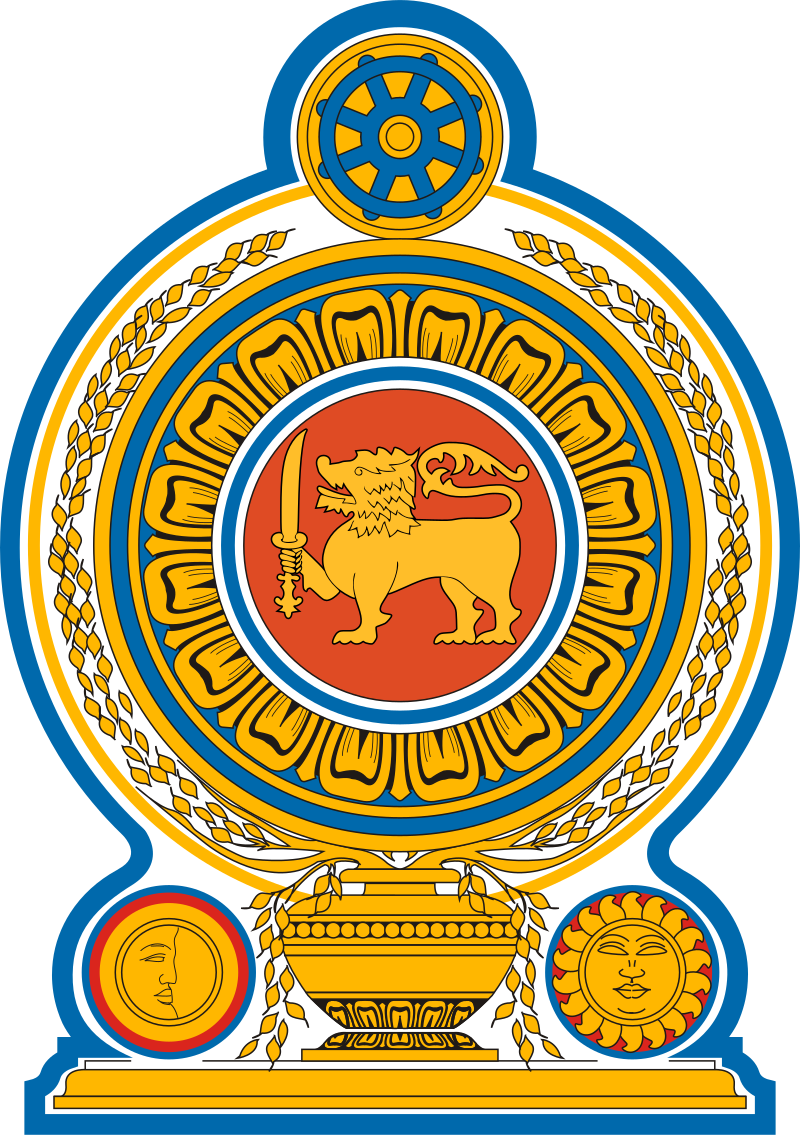
The national emblem of Sri Lanka is used by the State of Sri Lanka and the Sri Lankan government in connection with the administration and government of the country. The current emblem has been in use since 1972 and created under the ideas and guidance of Nissanka Wijeyeratne. At the time, he was Permanent Secretary to the Ministry of Cultural Affairs and Chairman of the National Emblem and Flag Design Committee. The designer of the emblem was Venerable Mapalagama Wipulasara Maha Thera, and the artwork was by S. M. Seneviratne.
The emblem features a gold lion passant, holding a sword in its right fore paw (the same lion from the flag of Sri Lanka) in the centre on a maroon background surrounded by golden petals of a Blue Lotus the national flower of the country. This is placed on top of a traditional grain vase that sprouts sheaves of rice grains that circle the border reflecting prosperity.
The crest is the Dharmachakra, symbolizing the country’s foremost place for Buddhism and just rule. Traditional Sinhalese heraldic symbols for the sun and the moon form the supporters.
Sri Lanka National Anthem
After independence was granted to Sri Lanka in 1948, the need for a national anthem arose. As a result of a contest, Ananda Samarkone’s contribution, written in Sinhalese, was chosen as the new anthem. The Tamil lyrics have the same meaning as the Sinhalese lyrics. It was first performed on the fourth anniversary of independence in early 1952.
Sinhala Lyrics of National Anthem |
|
|
Sri Lanka Matha, apa Sri Lanka,
Namo
Namo Namo Namo Matha.
Sundara
siri barini,
Surändi athi
Sobamana Lanka
Dhanya dhanaya
neka mal pala thuru piri, jaya
bhoomiya ramya.
Apa hata säpa
siri setha sadana, jee vanaye
Matha!
Piliganu mana apa bhakti
pooja,
Namo Namo Matha.
Apa
Sri Lanka,
Namo Namo Namo Namo
Matha,
apa Sri Lanka, Namo Namo
Namo Namo Matha.
Obave apa vidya obamaya apa sathya obave apa shakti
apa hada thula bhakti oba apa
aloke
apage anuprane oba apa
jeevana ve
apa muktiya obave
Nava
jeevana demine nithina apa
Pubudu
karan matha
Gnana veerya
vadavamina ragena yanu
mana
jaya bhoomi kara
Eka mavekuge
daru kala bavina
yamu yamu wee
nopama
Prema vadamu sama bheda
durara da
Namo Namo Matha
Apa Sri Lanka Namo Namo Namo Namo
Matha
Sri Lanka National Flag
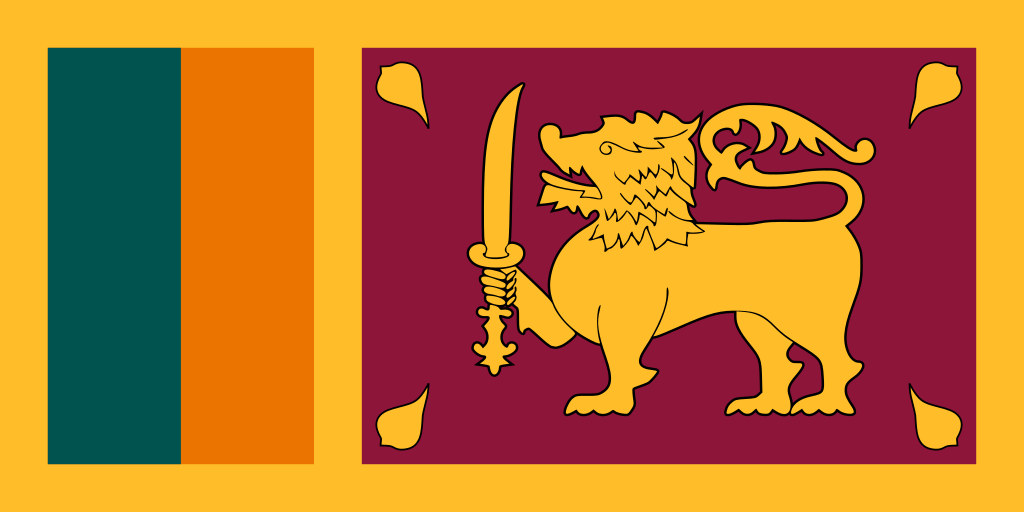
The National Flag of Sri Lanka represents the country and her heritage as rallying device that integrates the minorities with the majority race.
Sri Lanka National Flag is an improvisation of the civil standard of the last king of Sri Lanka, Sri Wickrama Rajasingha.
The civil standard had a passant royal lion with a sword in it’s right fore paw at the center, and a bo-leaf on each of the four corners on a plain border.
When Sri Lanka gained her independence from Great Britain on February 04, 1948, it was the lion flag of the last king of Sri Lanka was hoisted once again.
The first Prime Minister of independent Sri Lanka, D.S.Senanayake, appointed a committee to advice the government on the design of a new national flag. The design approved by the committee in February 1950 retained the symbol of the lion with the sword and the bo-leaves from the civil standard of the last king of Sri Lanka, with the inclusion of two vertical stripes green and orange in color.
The significance of each symbol of the national flag is as follows:
- The lion in the flag represents the Sinhala race.
- The sword of the lion represents the sovereignty of the country.
- Curly hair on the lion’s head indicates religious observance, wisdom and meditation.
- The beard denotes purity of words.
- The handle of the sword highlights the elements of water, fire, air and earth.
- The nose indicates intelligence.
- The two front paws purport to purity in handling wealth.
- The vertical stripe of orange represent the minority Tamil race and the green vertical stripe the minority Muslim race.
- The four virtues of kindness: KINDNESS, FRIENDLINESS, HAPPINESS, EQUANIMITY are also represented in the flag.
- The border round the flag, which is yellow in color, represents other minor races.
- The bo-leaves at the four corners of the flag represent Buddhism and it’s influence on the nation. They also stand for the four virtues – Kindness, Friendliness, Happiness and Equanimity.
- The maroon colored portion of the flag manifests the other minor religions.
The national flag was hoisted for the first time on March 3, 1950.
Sri Lanka National Tree
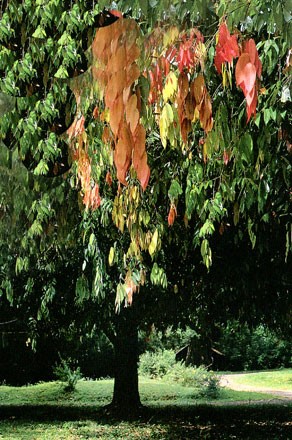
The Ironwood (Na Tree), botanically
known as ”Mesua Nagassarium” was
declared the National Tree on 26th
February 1986.
It was chosen as the National Tree
for several reasons.
- It is a tree which originated in Sri Lanka
- Its utility
- Historic and cultural importance
- Exterior posture
- Wide distribution
- Colour and nature
- Ability to draw and sketch it easily
This rain forest tree grows to about 30 m high and indigenous to the lower wet Zone of Sri Lanka. Remarkable Features of NA is beautiful bright Red Leaves and finally matured in to a deep green. Timber has a very hardness and durability and used to make bridges in the early times. Now it is not allowed to use for timber due to its religious value. The flower of NA is also used in herbal medicine and preparation of perfumes, cosmetics and soaps.
It is believed that the first visit of Buddha was to grove of a NA Tree at mahiyangana and also the next Buddha (Maitreya) will attain enlightenment under a NA tree.
Sri Lanka National Flower
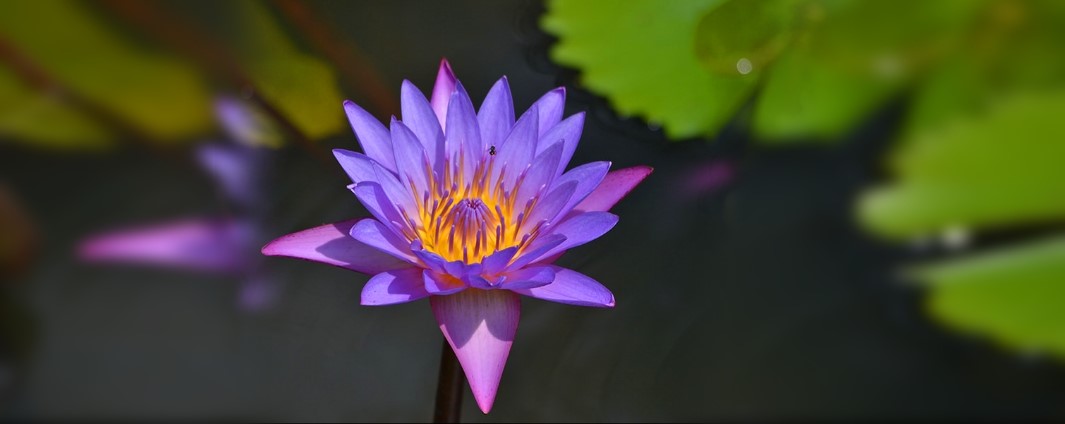
The “Nil Mahanel” flower, botanically known as “Nymphaea stellata” was declared the National Flower of Sri Lanka on 26th February 1986.
Sri Lanka National Bird
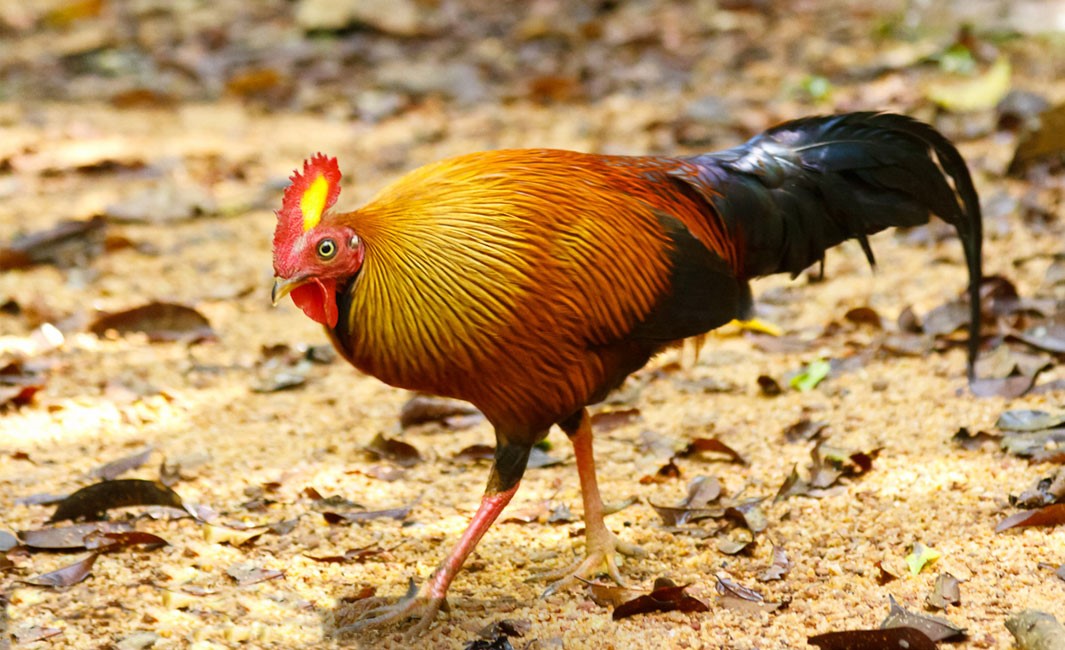
Sri Lanka Jungle Fowl – Very colorful ground bird, endemic to Sri Lanka is the national bird of Sri Lanka. Distributed commonly in Sri Lanka’s jungle and dense scrub through out. Roosts high in trees at nights. Flies up to tree branches when threatened. Nests in hidden, scraped place on the ground or on a pile of vegetation just off the ground. Sinharaja is a very good site to watch Sri Lanka Jungle Fowl.


